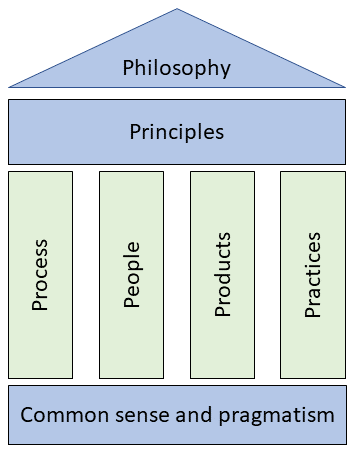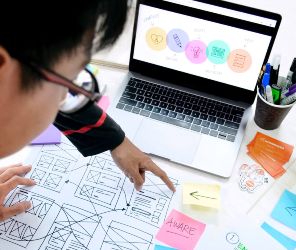
Background
The Dynamic Systems Development Method (DSDM) is sometimes referred to as the best-kept secret of Agile.
Introduced in 1995, DSDM is the oldest Agile method and uniquely focuses on managing Agile projects.
In the early 2000s, DSDM gained traction among software developers looking for alternatives to rapid application development (RAD) techniques. A key challenge with RAD was its limited scalability for team collaboration. DSDM addressed this by fostering collaboration within the team and at scale, becoming one of the earliest Agile methodologies used by the software development community.
DSDM was present at the Agile Alliance’s launch and the release of the Agile Manifesto in 2001. DSDM’s philosophy and principles contributed to the development of the Manifesto for Agile Software Development, although DSDM expands the Agile concept beyond just software.
In short, DSDM was practicing Agile before it became mainstream!
The Advent of DSDM Atern
In 2007, the DSDM methodology underwent a significant update and became known as DSDM Atern. The term ‘Atern’ was inspired by the Arctic Tern, a bird reputed for its highly cooperative nature and ability to traverse enormous distances. This metaphor aptly represented the rebranding of the DSDM method.
In 2014, due to confusion caused by the term ‘Atern,’ another revision to the method was made. The decision was taken to return to the original DSDM name, which was universally recognized. Therefore, DSDM and DSDM Atern are now synonymous!
Agile Project Framework in DSDM
With the 2014 rebranding of DSDM, the Agile Project Framework was incorporated. The DSDM Agile Project Framework has become the foremost, proven agile approach that addresses both the governance and rigor needs along with the agility and flexibility demands of today’s organizations.
The Agile Project Framework of DSDM helps organizations overcome typical project challenges such as late deliveries, exceeding costs, or final deliverables not meeting the intended purpose.
AgilePM and DSDM
DSDM was the first agile framework to include agile project management capabilities. In contrast to Scrum, which only focuses on product delivery during an iteration, DSDM encompasses project management aspects as well. This unique characteristic differentiates DSDM from the majority of other agile frameworks.
DSDM’s ability to cater to diverse agile needs led to its adoption as the basis for the fast-growing AgilePM (Agile Project Management) qualifications, which are accredited by APMG International and the Agile Business Consortium.
DSDM – Agile Approach Innovation
DSDM framework initially developed to efficiently deliver software projects. Like other agile frameworks and methodologies, DSDM emerged in response to the problematic waterfall processes that had become prevalent in the software development industry during the late 20th century.
DSDM’s Evolution
DSDM is now evolving as agile methodologies mature. This evolution is due to organizations requiring increased rigor and control when applying agile in situations where the ‘ideal agile environment’ is lacking.
DSDM is an agile method that addresses the needs of both simple product development projects with co-located teams, and more complex projects involving multiple distributed teams working in different countries and time zones. DSDM can scale up to accommodate multiple teams working in distributed settings, a feature that scaled agile frameworks have only recently begun to offer.
DSDM Insights
Not Limited to IT
Although DSDM, like most agile frameworks and methods, has its roots in the software development industry, agile has progressed over the last decade and is no longer restricted to IT.
DSDM can be readily applied to projects other than software development. In fact, it can be employed for any type of product development project. By delivering a functional product incrementally at the conclusion of each timebox, DSDM can offer business value early in the product development lifecycle.
Standalone or Combined DSDM
The DSDM Agile Project Framework can be utilized either as a standalone approach or combined with other established project management methods like PRINCE2, MSP, and PMI.
It is also ideal as a wrapper for narrower Agile approaches such as Scrum, ensuring the whole project lifecycle is addressed. DSDM also allows Scrum to be scaled up for purposes beyond just product development.
DSDM Features

DSDM is an agile project framework that includes several dimensions:
- philosophy
- principles
- process
- people
- products
- practices
- pragmatism and common sense.
These dimensions collectively uphold a philosophy of delivering business benefits as soon as possible, ensuring the best return on investment (ROI) for an organization.
DSDM’s ‘judiciousness and pragmatism’ might appear unconventional to some, but this flexibility helps DSDM avoid the dogmatic tendencies that can sometimes beset other Agile approaches.
A fundamental belief of DSDM is that nothing is built perfectly on the first attempt. As a general rule, 80% of a solution’s value can be delivered for 20% of the effort required to produce the full solution.
By emphasizing the business need, DSDM supports projects that strategically align with an organization’s change portfolio.
DSDM principles
DSDM is founded on 8 core principles that represent its spirit, culture, and approach to work. These principles must be actively monitored at all times, as any compromise on a principle can jeopardize the successful execution and completion of a project.
DSDM aligns closely with agile principles, focusing on delivery, effective communication, collaboration, and continuous delivery. All DSDM principles contribute to harmonizing DSDM practices with the agile philosophy.
Familiarizing yourself with DSDM’s guiding principles is crucial if you’re considering enrolling in an agile project management course, such as AgilePM®, which is based on the DSDM method.
We will now look at the 8 DSDM principles.
1. Focus on the business need
- Understand business priorities.
- Create a valid business case.
- Enable continuous business commitment.
All decisions made within your project must correspond with the broader project objectives. Projects ought to function as a pathway to achieve long-term business goals. Methods like MoSCoW and timeboxing assist in maintaining focus on delivering what businesses require, precisely when they require it.
2. Deliver on time
- Use timeboxing.
- Focus on priorities.
- Predict deliveries.
Delivering products within the designated timeline is usually a firm requirement. For uniform deliveries, set up all timeboxes beforehand. Features may be diverse, but delivery dates must invariably remain constant.
3. Cooperate and collaborate
- Promote stakeholder collaboration.
- Focus on team building.
- Work with business representatives.
Collaboration and decision-making should be achievable for teams on behalf of those they represent. Make sure to have subject matter experts in your team for efficient information dissemination. Stakeholders can communicate their knowledge and experiences with project teams by means of consistent workshops.
4. Never compromise quality
- Set quality level at the start.
- Ensure quality doesn’t vary.
- Document and test.
Establish the desired quality level in the beginning. All efforts should be directed toward achieving this pre-defined level. Assess deliverables early and constantly review them.
5. Build incrementally
- Deliver business benefit early.
- Reassess priorities with each iteration.
- Confirm that the work is correct.
According to DSDM, before starting development, it is crucial for teams to grasp the extent of the business problem at hand. Do not get so entangled in analyzing requirements that development becomes stagnant.
6. Develop iteratively
- Use customer feedback.
- Create Enough Design Up Front (EDUP).
- Evolve and be creative.
DSDM places great importance on the notion of iterative delivery. Understand that perfection is seldom achieved initially, and adopting changes in your project is key to success.
7. Communicate continuously
- Manage expectations.
- Keep documentation simple.
- Interact through workshops.
Foster team collaboration with regular stand-ups and workshops. Show your work early and consistently through models and prototypes. Encourage casual, face-to-face communication among team members.
8. Demonstrate control
- Be proactive.
- Timebox work and review regularly.
- Evaluate project viability.
Boost project oversight by providing visibility of plans and progress to all members. Establish formal documentation procedures. Determine progress by focusing on the products delivered instead of tasks finished.
Processes
DSDM operates in an iterative and incremental manner. Early delivery of the most vital business needs is prioritized, with less critical ones delivered later on.
DSDM’s iterative aspect enables business representatives to observe a solution as it evolves, provide feedback, and propose changes throughout its development.
Phases
The DSDM process model comprises 6 phases. A unique pre-project phase and post-project phase distinguish it from most other Agile methods that concentrate on delivery alone.
The DSDM phases are:
- Pre-project.
- Feasibility.
- Foundations.
- Evolutionary development.
- Deployment.
- Post-project.
People
DSDM brings together people from business and development contexts throughout the iterative and incremental process.
All team members in a project have defined roles and tasks, working collectively in timeboxes to maintain the project’s timeline.
The project manager’s responsibilities are explicitly described in DSDM, unlike in other Agile methodologies.
Practices
DSDM advocates for 4 main practices.
Timeboxing
In DSDM, like many agile frameworks, work is planned within fixed timeframes (timeboxes) akin to Scrum’s sprints. The objective is to deliver a usable product after each iteration (timebox). Consequently, DSDM follows both an incremental and iterative strategy for product development.
Facilitated workshops
Facilitated workshops gather project stakeholders to work together in defining business requirements and promoting shared understanding.
Modelling and iterative development
Modelling helps team members to visualize a business domain, improving their grasp of it. Modelling aids in devising diagrammatic representations of specific components of the system or business area under development.
DSDM utilizes a short feedback loop with the customer to deliver an incremental, functional release of software at the end of each iteration. The MoSCoW prioritization technique is recommended for selecting the requirements for the team to tackle during a timebox. Requirements are generally expressed as user stories.
DSDM also incorporates prototyping, focusing on rapid development, swift feedback, and early problem detection. The core DSDM philosophy emphasizes the importance of identifying and addressing issues as soon as possible.
MoSCoW prioritization
The MoSCoW prioritization method assists businesses in organizing their requirements by categorizing them as Must have, Should have, Could have, or Won’t have within each timebox, ensuring a clear hierarchy of needs.
Distinguishing DSDM from Scrum
There is often confusion within the Agile community, with many people incorrectly assuming that Scrum is a project management technique. In actuality, Scrum is a development method that encourages team collaboration on project and non-project tasks to iteratively produce valuable products for customers.
Scrum does not encompass activities that occur before the project (pre-project) or after the solution has been deployed (post-project). Pre-project involves determining the project’s worthiness, while post-project requires examining the benefits of the solution and deciding whether additional improvements are necessary.
In comparison, DSDM includes the pre-project and post-project stages and delineates the project manager’s roles and responsibilities. DSDM serves as an agile project management framework, while Scrum is a product delivery framework. Scrum can be employed within DSDM projects during the other four project phases.
DSDM infographic
The following infographic shows the DSDM principles in greater detail.

Summary
The DSDM Agile Project Framework is a well-established and reliable method for agile project delivery. It has been successfully utilized in numerous projects worldwide.
DSDM is currently the only existing agile project management framework. The framework continues to demonstrate its effectiveness in working within and supplementing existing corporate processes.
DSDM’s use in IT and non-IT projects dates back to 1994, and its significant productivity improvements have been independently confirmed by the UK Software Metrics Association.
For more information on how DSDM can benefit your Agile project delivery, or for details about agile project management training, please reach out to us at agileKRC.
agileKRC has helped shape agile thinking by leading the teams that developed AgilePM® and PRINCE2 Agile®. We take a practical, success-oriented approach. We begin by taking the time to listen and understand your needs, before offering our real-world experience and expert guidance.













